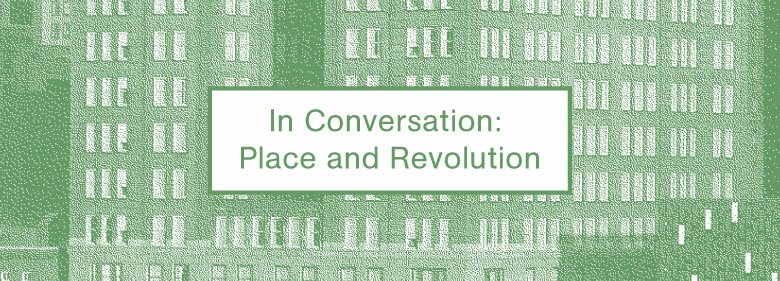Of Other Places*
We talk frequently, despite being half a world apart––through texts, Skype, on buses, in cabs, and at conferences (lots of these over the last few years…). We always exchange names of exciting projects. We ponder the ways such work can be taught, the limitations of a canon, of sanctions, of efficacy, and codifying this sort of work. We also talk about our children, and sometimes ice cream.
We decided to not start a new conversation for this blog, opting to just open up the ongoing one to a wider audience.
Chicago in place
We waded through the thick snow after a tedious day at the annual conference of the College Art Association 2014 in Chicago. We cabbed across the city to Jane Addams Hull-House[i] for the “social practitioners” spaghetti bolognaise dinner, the first of two; the second after November’s A Lived Practice Symposium. We encountered a legacy thick and celebrated, like a historical park or a living history exhibition. Somehow, the history of Dewey and Addams, of social service and settlement, is conflated with contemporary art. Hull-House has become metonym for the aspirations of a generation of artist activists in Chicago and beyond. A social history heterotopia: at once real and at the same time abstracted and virtual.
San Francisco in place
Our first conversations were about San Francisco and its current and historical legacy as a site of progressive cultural values and vanguard art practices, and the relationship––if any––to the Social Practice MFA at California College of the Arts (Gretchen as a student; Ted as the newly appointed leader of Social Practice). We looked at the spectrum of its genealogy: Gómez-Peña’s radical pedagogy, the SF Diggers’ influence on Amy Franceschini’s Future Farmers to Tom Marioni’s salon (and career) revival in the wake of participatory art’s ubiquity in The Bay Area.
What about place and revolution?
Simple questions beg for complexity. What do place and revolution even mean? These two questions are remote from each other––they live apart. They imply a relationship exists or is in some sort of dialectical drama with time and place.
Aligning art with revolution contains a fundamental contradiction (Ben Davis). Contemporary art, as a practice, as a preoccupation, and as a philosophical pursuit binds itself tightly subjectivity and freedom. Any classical (i.e. Marxian) notion of revolution (that would be Revolution with a capital R, not just some sort of change or shift) must, by definition, be accompanied by unified class struggle––no authors allowed. A community of practitioners working for social change, well that shifts the tide in favor of a heterotopia: existing in a world, outside a world, and critical to both.
And place… how do we navigate a place now? Everyplace is two, four or six places at once––as we check a screen when we walk down a crowded sidewalk, reference a navigation program when we are getting a coffee, read a historical marker. Certainly the social and the public exist in a place, but that place is layered, and we have to account for this layering. It no longer suffices to say a place is singular historically, physically, or practically.
Place has been hijacked by placemakers, and the horizons multiply.
If art is to produce revolution in place, then it may be necessary to pluralize everything. Everything. Revolutions and places, layers of revolution in multi-places, networks of tentacles spreading out into the vast expanse….to establish those heterotopias, tangible and hidden. We make our palimpsests: in communities of our own making, situated in worlds both real and imagined, layered with discourses, networks, hopes, dreams, instances of provocations, percolating revolutions, with time for coffee, a ride across a city, and friend requests…
We will continue the conversation again, as we will both be there, again, in all the Pittsburghs, all at the same time.
Photo: Ted Purves
*Titled after Michel Foucault’s “Of Other Spaces, Heterotopias.” Architecture, Mouvement, Continuité 5 (1984): 46-49.
[i] Jane Addams (1860-1935) was an American social activist and suffragette. For more information please see http://www.uic.edu/jaddams/hull/hull_house.html
About the contributors: Gretchen Coombs lives and works in Brisbane, Australia where she teaches in the School of Design at Queensland University of Technology. Her interests include art and design criticism/activism, specifically recent practices that challenge social structures within urban contexts. Her research involves artists, collectives, educators, and curators who are immersed in new ways of practicing art that intervenes in social and cultural processes to imagine new political subjectivities. Gretchen’s ethnographic research will culminate in a book entitled The Lure of the Social: ethnographies of practice in contemporary art (Intellect 2016).
Ted Purves is a writer and artist based in Berkeley, California. His public projects and writings are centered on investigating the practice of art in the world, particularly as it addresses issues of localism and power, systems of exchange, and critical occupations of social forms. He produces socially-based projects in collaboration with Susanne Cockrell under the umbrella name of Fieldfaring. Their most recent project, The Red Bank Pawpaw Circle, a large public planting project, was completed in Cincinnati, Ohio in Fall 2012.
Purves was the founder of the MFA concentration in Social Practice at California College of the Arts in 2005, and is currently the Chair of the MFA Fine Arts Program. His book, What We Want is Free: Generosity and Exchange in Recent Art, was published by SUNY Press in 2005. An expanded edition––What We Want Is Free: Critical Exchanges in Recent Art, co-edited with Shane Aslan Selzer, was published by SUNY Press in early 2014.

